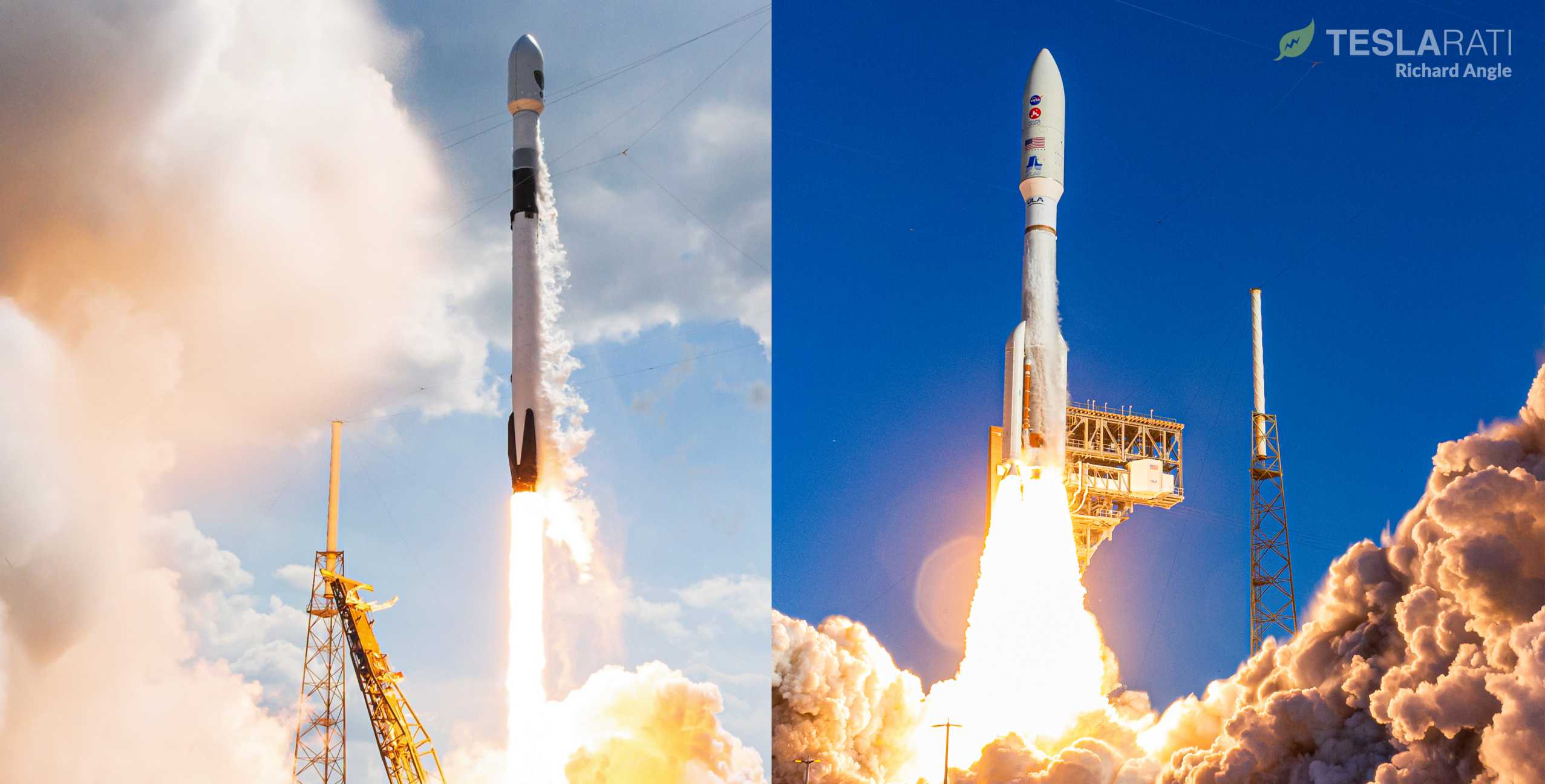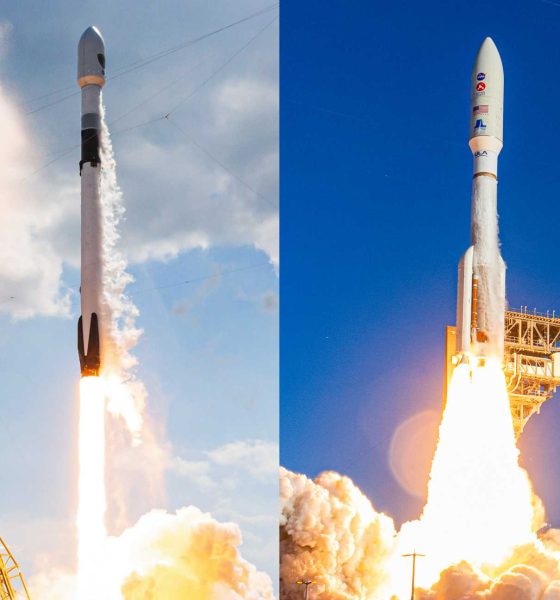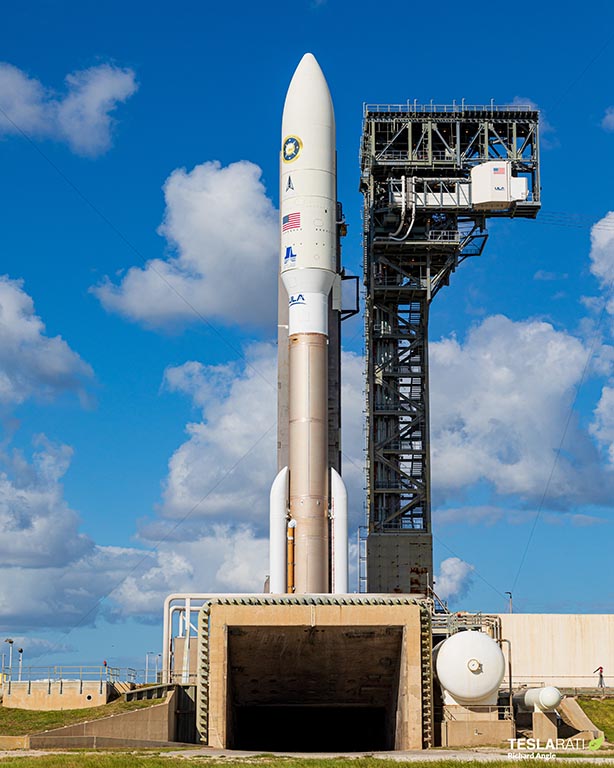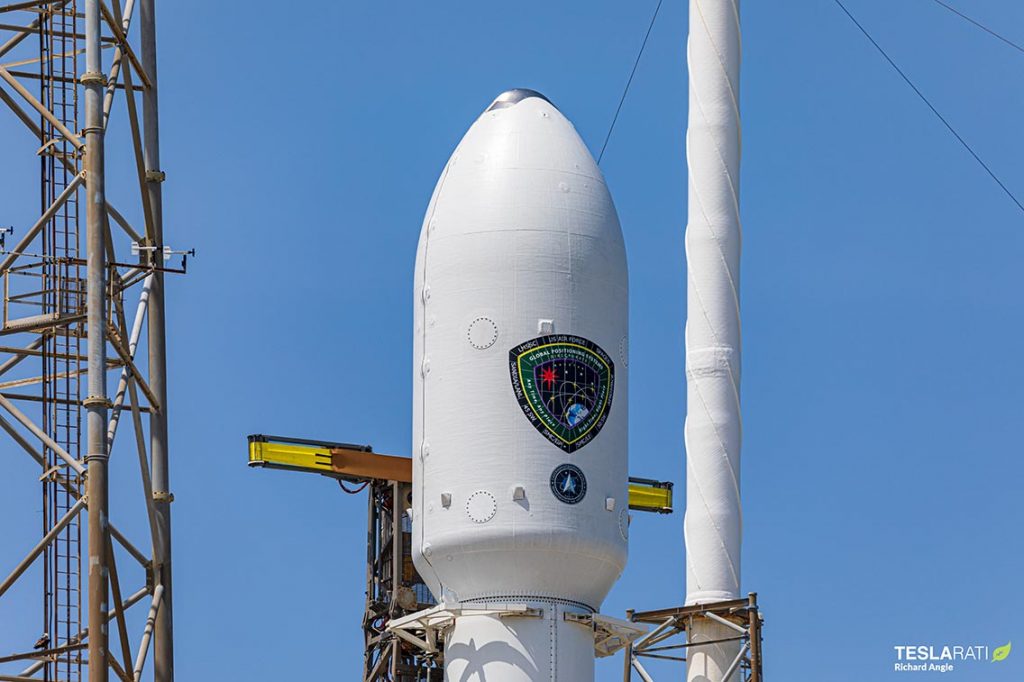

News
SpaceX Falcon 9 launch up next after ULA spy satellite mission hits snag
On Wednesday, November 3, a United Launch Alliance (ULA) Atlas V 531 rocket was set to launch the NROL-101 mission – a classified payload for the National Reconnaissance Office (NRO) of the United States government – from Space Launch Complex 41 (SLC-41) at Cape Canaveral Air Force Station. At neighboring Space Launch Complex 40 (SLC-40) a SpaceX Falcon 9 stood ready and waiting to launch a US military GPS satellite just a day later.
Ultimately, due to an anomaly with launchpad ground support equipment, the ULA launch attempt of the Atlas V NROL-101 mission was scrubbed Wednesday evening. Admittedly, the weather did not look promising either with ground winds remaining a concern throughout the countdown window.
With an hour and forty-seven minutes to go – just five seconds after a planned fifteen-minute hold was released – the launch teams announced that an anomaly had been discovered with “a ground valve issue with the liquid oxygen system for the Atlas V first stage.” The discovery initiated an immediate stop to the countdown and launch teams entered into an unplanned hold that would delay the targeted launch time.
At first, ULA conducted remote troubleshooting, but the anomaly was not remedied and a return-to-pad team would be required to enter the secured launchpad to physically investigate.

An anomaly team was deployed to investigate the valve that was restricting the flow of liquid oxygen (LOx) to the first stage of the Atlas V rocket. The hold remained for over an hour allowing the propellant lines to warm to a temperature that would be needed to be re-cooled prior to resuming the countdown.
Eventually, the return-to-pad team was able to evacuate the pad securing it for launch once again. Chill-down procedures to return the propellant lines back to an operational temperature began but were halted almost immediately. The anomaly had not been completely rectified and not enough time remained in the launch window to re-address it and re-chill the propellant lines. This led to the scrubbed launch attempt.
Typically, a scrubbed ULA mission for the NRO means that a neighboring SpaceX mission has to wait until the problem is fixed and ULA gets its rocket off of the nearby launchpad. However, that was not the case with Wednesday’s scrub. ULA stood down for a 48 hour recycle – rather than a typical 24 hour recycle – to attempt to launch the Atlas V 531 again on Friday, November 6.
This cleared the way for SpaceX to keep its targeted launch date of Thursday, November 5 during a launch window that extends approximately fifteen minutes from 6:24 – 6:39 p.m. EST (2324-2339 UTC) from SLC-40.

Following a successful static fire test of all nine Merlin 1D engines, SpaceX will attempt to launch the GPSIII-SV04 satellite for the United States military for a second time on Thursday, November 5.
The previous launch attempt on Friday, October 2 was thwarted at T-2 seconds due to anomalous engine start-up behavior. The unexplained early start-up of two Merlin 1D engines was eventually determined to be caused by “unexpected pressure rise in the turbomachinery gas generator” as explained by SpaceX CEO Elon Musk.
The engine anomaly prompted a thorough investigation of all Merlin 1D engines on the launch vehicle, as well as, a thorough investigation of the engines on two Falcon 9 launch vehicles designated for future NASA missions – the first operational rotation mission of the Commercial Crew Program, Crew-1, and the launch of the NASA and European Space Agency Earth-observation satellite, the Micheal Freilich Sentinel-6. Engines were eventually replaced on all three Falcon 9 launch vehicles.
A live hosted webcast of Thursday’s launch attempt will be provided on the company website and is expected to be available for viewing approximately fifteen minuted before liftoff.
Check out Teslarati’s Marketplace! We offer Tesla accessories, including for the Tesla Cybertruck and Tesla Model 3.

News
Tesla FSD fleet is nearing 7 billion total miles, including 2.5 billion city miles
As can be seen on Tesla’s official FSD webpage, vehicles equipped with the system have now navigated over 6.99 billion miles.

Tesla’s Full Self-Driving (Supervised) fleet is closing in on almost 7 billion total miles driven, as per data posted by the company on its official FSD webpage.
These figures hint at the massive scale of data fueling Tesla’s rapid FSD improvements, which have been quite notable as of late.
FSD mileage milestones
As can be seen on Tesla’s official FSD webpage, vehicles equipped with the system have now navigated over 6.99 billion miles. Tesla owner and avid FSD tester Whole Mars Catalog also shared a screenshot indicating that from the nearly 7 billion miles traveled by the FSD fleet, more than 2.5 billion miles were driven inside cities.
City miles are particularly valuable for complex urban scenarios like unprotected turns, pedestrian interactions, and traffic lights. This is also the difference-maker for FSD, as only complex solutions, such as Waymo’s self-driving taxis, operate similarly on inner-city streets. And even then, incidents such as the San Francisco blackouts have proven challenging for sensor-rich vehicles like Waymos.
Tesla’s data edge
Tesla has a number of advantages in the autonomous vehicle sector, one of which is the size of its fleet and the number of vehicles training FSD on real-world roads. Tesla’s nearly 7 billion FSD miles then allow the company to roll out updates that make its vehicles behave like they are being driven by experienced drivers, even if they are operating on their own.
So notable are Tesla’s improvements to FSD that NVIDIA Director of Robotics Jim Fan, after experiencing FSD v14, noted that the system is the first AI that passes what he described as a “Physical Turing Test.”
“Despite knowing exactly how robot learning works, I still find it magical watching the steering wheel turn by itself. First it feels surreal, next it becomes routine. Then, like the smartphone, taking it away actively hurts. This is how humanity gets rewired and glued to god-like technologies,” Fan wrote in a post on X.
News
Tesla starts showing how FSD will change lives in Europe
Local officials tested the system on narrow country roads and were impressed by FSD’s smooth, human-like driving, with some calling the service a game-changer for everyday life in areas that are far from urban centers.

Tesla has launched Europe’s first public shuttle service using Full Self-Driving (Supervised) in the rural Eifelkreis Bitburg-Prüm region of Germany, demonstrating how the technology can restore independence and mobility for people who struggle with limited transport options.
Local officials tested the system on narrow country roads and were impressed by FSD’s smooth, human-like driving, with some calling the service a game-changer for everyday life in areas that are far from urban centers.
Officials see real impact on rural residents
Arzfeld Mayor Johannes Kuhl and District Administrator Andreas Kruppert personally tested the Tesla shuttle service. This allowed them to see just how well FSD navigated winding lanes and rural roads confidently. Kruppert said, “Autonomous driving sounds like science fiction to many, but we simply see here that it works totally well in rural regions too.” Kuhl, for his part, also noted that FSD “feels like a very experienced driver.”
The pilot complements the area’s “Citizen Bus” program, which provides on-demand rides for elderly residents who can no longer drive themselves. Tesla Europe shared a video of a demonstration of the service, highlighting how FSD gives people their freedom back, even in places where public transport is not as prevalent.
What the Ministry for Economic Affairs and Transport says
Rhineland-Palatinate’s Minister Daniela Schmitt supported the project, praising the collaboration that made this “first of its kind in Europe” possible. As per the ministry, the rural rollout for the service shows FSD’s potential beyond major cities, and it delivers tangible benefits like grocery runs, doctor visits, and social connections for isolated residents.
“Reliable and flexible mobility is especially vital in rural areas. With the launch of a shuttle service using self-driving vehicles (FSD supervised) by Tesla in the Eifelkreis Bitburg-Prüm, an innovative pilot project is now getting underway that complements local community bus services. It is the first project of its kind in Europe.
“The result is a real gain for rural mobility: greater accessibility, more flexibility and tangible benefits for everyday life. A strong signal for innovation, cooperation and future-oriented mobility beyond urban centers,” the ministry wrote in a LinkedIn post.
News
Tesla China quietly posts Robotaxi-related job listing
Tesla China is currently seeking a Low Voltage Electrical Engineer to work on circuit board design for the company’s autonomous vehicles.

Tesla has posted a new job listing in Shanghai explicitly tied to its Robotaxi program, fueling speculation that the company is preparing to launch its dedicated autonomous ride-hailing service in China.
As noted in the listing, Tesla China is currently seeking a Low Voltage Electrical Engineer to work on circuit board design for the company’s autonomous vehicles.
Robotaxi-specific role
The listing, which was shared on social media platform X by industry watcher @tslaming, suggested that Tesla China is looking to fill the role urgently. The job listing itself specifically mentions that the person hired for the role will be working on the Low Voltage Hardware team, which would design the circuit boards that would serve as the nervous system of the Robotaxi.
Key tasks for the role, as indicated in the job listing, include collaboration with PCB layout, firmware, mechanical, program management, and validation teams, among other responsibilities. The role is based in Shanghai.
China Robotaxi launch
China represents a massive potential market for robotaxis, with its dense urban centers and supportive policies in select cities. Tesla has limited permission to roll out FSD in the country, though despite this, its vehicles have been hailed as among the best in the market when it comes to autonomous features. So far, at least, it appears that China supports Tesla’s FSD and Robotaxi rollout.
This was hinted at in November, when Tesla brought the Cybercab to the 8th China International Import Expo (CIIE) in Shanghai, marking the first time that the autonomous two-seater was brought to the Asia-Pacific region. The vehicle, despite not having a release date in China, received a significant amount of interest among the event’s attendees.








